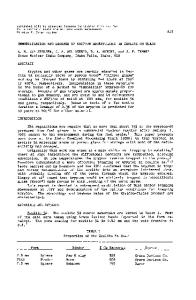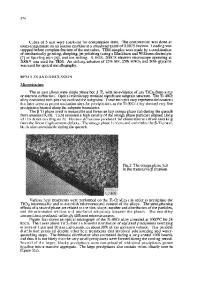Precipitation of Krypton in an Amorphous Ti-Cr Alloyc.
- PDF / 1,951,980 Bytes
- 6 Pages / 417.6 x 639 pts Page_size
- 104 Downloads / 275 Views
PRECIPITATION OF KRYPTON IN AN AMORPHOUS TI-CR ALLOYC. W. ALLEN AND R. C. BIRTCHER Materials Science Division, Argonne National Laboratory, Argonne, IL 60439,
USA
ABSTRACT Results of a TEM investigation of the microstructural changes produced by the room temperature implantation of energetic Kr+ ions into a glassy Ti-Cr thin film are reported. As in other metals, the Kr precipitates as solid crystallites. The precipitation of crystalline Kr is accompanied by ultrafine crystallization of the metal host around each Kr crystal. With increasing fluence, the Kr precipitates grow to a critical size at which they melt, and the adjacent fine metal crystals disappear. A new TEM imaging technique is described briefly which utilizes the small angle electron scattering fine structure and which in principle is capable of revealing all fine particles simultaneously. INTRODUCTION In pure metals, the implantation of Kr to dose levels of order 1016 to 1017 cm-2 (concentrations of several atom percent) results in Kr precipitation into cavities which are rendered visible by standard TEM techniques. In all metals investigated, the Kr forms individual crystals which are endotaxially oriented with respect to the host lattice and which persist as a solid to more than 600 K above the normal melting point of Kr under one atmosphere pressure [1,2]. With increasing Kr fluence in Ni and Al, the small Kr crystals grow in size while their number density decreases. Above a critical size, the solid Kr melts and further growth of the Kr precipitates becomes very rapid. The state of the Kr was analyzed with reference to its thermodynamic equation of state and the equilibrium pressure computed for different size cavities. The pressures were as high as 36kBar. The Ti-Cr alloy being studied here can be made amorphous during its preparation by coevaporation or by irradiation with energetic ions. Its behavior when high concentrations of rare-gas atoms have been implanted is quite complex. EXPERIMENTAL METHODS Amorphous films approximately 78 nm thick were prepared by coevaporation and sublimation of high purity Ti and Cr onto freshly cleaved rock salt crystals at room temperature. The films were composed of 46 at. pct Cr and were amorphous. The coated salt was cleaved into small pieces, and specimens were floated on a water-methanol mixture onto Ti TEM grids. Irradiations were performed at room temperature with either 100 keV Kr+ ions in a target chamber or with 55 keV Kr+ ions within an HVEM [3]. In the latter experiments, in siLu ion irradiations were performed in the HVEM-Tandem National User Facility at 2Argonne. During either implantation the dose rate was approximately 2x101 cm- s -. The experimental arrangement of the sample in the HVEM is shown in Fig. 1. The specimen was tilted 30 deg so that it is nearly normal to the incident Kr flux and thus the TEM observations could be made simultaneously. Based upon results from the TRIM computer code [4], the depth distribution of the 100 keV Kr ions peaks near the foil center and decreases to zero nea
Data Loading...









